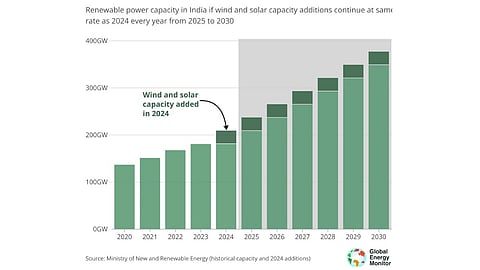

Global Energy Monitor recommends accelerating the rollout of renewable energy in India for the country to meet 500 GW target by 2030
Even though the total installed capacity of wind, solar and hydropower will overtake coal over the next 2 years, fossil fuels will still dominate with their higher utilization rates
The government will need to tackle challenges at various levels to speed up renewables, including infrastructure issues and high financing costs
India targets to achieve 500 GW of non-fossil fuel installed power generation capacity by 2030, up from the current 165 GW. In 2024, it installed a record of 35 GW of new renewable energy capacity, led by solar PV. If it can double this pace of renewable energy deployment annually till 2030, the country can meet the 500 GW target, according to a new report from the Global Energy Monitor (GEM).
Solar PV installations of 24.5 GW accounted for 71% of total capacity additions across the power sector. Utility-scale solar made up 75% of these additions followed by the distributed generation segment, thanks primarily to the country’s flagship rooftop solar scheme PM Surya Ghar: Muft Bijli Yojana (PMSGMBY) (see Utility-Scale Solar Powers India’s Record 24.5 GW PV Installations In 2024).
“The impressive growth of renewables in the last year, especially solar, shows how serious India is taking its climate targets. The clean energy transition is well underway, but without continued and sustained growth of wind and solar coal will continue to reign supreme,” said GEM’s Project Manager for the Global Integrated Power Tracker, James Norman.
Wind energy additions, on the other hand, were much lower in comparison at 3.4 GW but were about 1/3rd higher than the average annual deployment over the last decade.
In 2024, renewables made up around 1/5th of the total increase in power generation, compared to fossil fuels accounting for more than 2/3rd. Reversing this trend will require accelerating the roll-out of renewable energy sources, according to US-based GEM that tracks fossil fuels and renewable energy projects globally.
The country’s current development pipeline of mostly utility-scale solar, along with wind and hydropower projects ensures the country is on track to overtake operating coal capacity within the next 2 years.
GEM explains, “However, a significant uptick in renewables deployment is required for these sources to expand upon their current one-fifth share of total generation and to eat into coal’s dominance. This is because renewables tend to generate less readily than fossil sources: Wind and solar have an average utilization rate of 17–22% across the year, compared to coal’s 70%.”
According to GEM’s Global Integrated Power Tracker, an additional hydropower capacity of 24 GW is scheduled to come online by the end of this decade. If India can replicate last year’s annual wind and solar deployment until the end of the decade, the country’s renewable energy fleet would expand around 80% to 378 GW. The remaining gap of 100 GW can be closed with a 15% year-on-year (YoY) growth in wind and solar energy capacity.
Achieving this expansion of renewables will require tackling various challenges including those related to the infrastructure in terms of electricity transmission and energy storage capacity, ensuring compliance with renewable purchase obligations and high financing costs.
“There are additional challenges related to just transition, encompassing conflicts over farmers’ and local community’s rights to access land, as well as livelihood impacts on those employed in coal-related industries,” reads the report that can be viewed for free on GEM’s website.
